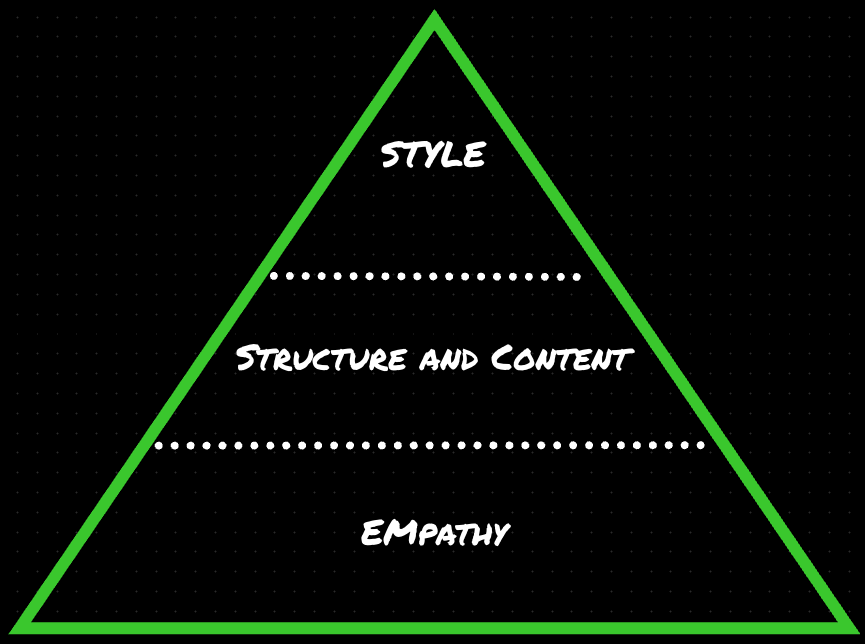Communicating for Impact: Beyond the Fluff
Communication skills go beyond projecting confidence and all the fluff.
Communicating for Impact was one of the modules I took in the McKinsey Forward Program. It was the most challenging module as it forced me to think hard about how I communicate in a professional, academic, and personal setting. The highlight of this module was learning that communication goes beyond just presenting and talking.

Communicating for impact based on the EPIC framework [1] means practising empathy, structuring your content by defining the purpose, articulating ideas in a structured manner, and delivering the conversation using the right style and tone. All three must work together to successfully deliver the message to the intended recipients for maximum impact.
Empathy is the Foundation of Communication
Communication involves the message giver (speaker) and receiver (listener). It is important to remember that a message must be clear to the receiver to catalyse positive change.
The first element of communication is empathy. In the context of communication, empathy entails active listening and understanding the receiver’s perspective. Empathy can also be practised through encouragement, reflection, leading questions, and offering help.
It is important to understand that empathy and sympathy are two different things. Empathy fuels connection by allowing one to feel with people and put oneself in their shoes. [2] On the other hand, sympathy only offers pity and drives disconnection. The lack of empathy can lead to misunderstandings, communication breakdown, and conflict.
Learning the importance of empathy in communication reminded me of my previous conversations with cross-functional stakeholders, which are common in my IT Audit and SOX work. Sometimes, my observations and recommendations were not well-received, even with the right structure and style, because I did not calibrate them to the perspective of the receiving stakeholder. Moving forward, one of the things I will add to my communication plan is the stakeholder map, which describes the stakeholders’ roles and interests to understand how I can influence them.
Organized Thoughts = Clear Message
I sometimes got frustrated with work messages because I did not understand the sender's request. The common theme? They all lack clarity! These experiences exemplify the importance of structure and content in communications.
The first step in building structure is identifying the conversation's purpose or written message. Take a step back and think about why you need to send your message in the first place. For example, you have identified improvements in how your stakeholders operate a key control for regulatory purposes. You know for a fact that the purpose of your message is to inform and influence the stakeholders to apply your recommendation. The purpose will set the tone for the content and structure of your message.
The next step is to organize your thoughts in preparation for your upcoming interaction. You want to ensure that your message's content flows logically so your stakeholders can follow.
There are several communication frameworks that you can use to deliver your point. My favourite is the Pyramid Principle, which I learned from the McKinsey Forward program. It starts with the key message or governing thought and then goes down to the supporting arguments to break down the key message into pieces. Supporting arguments should be backed by data and facts. There should be no overlaps or gaps at all levels. [3]
Finally, it’s good practice to synthesize your message by answering the “so what” question to trigger your intended recipient to act on it. In the process improvement example, one way to apply this is to convince your stakeholders that following your recommendation will result in cost savings and improved transparency without sacrificing regulatory compliance.
Deliver with Style (Not Fluff!) for Maximum Impact
A common misconception I encountered over the years was the notion of style in communication. I remember early in my career when I was told to present by speaking in an unnatural tone to project confidence. Unfortunately, I felt the presentation did not go well, as I could not deliver the message the way I intended. Looking back, I realized after some practice and my leadership class during my MBA that confidence does not mean being the loudest in the room. One of the things that will stick with me was when one of my professors confirmed that style does not have one mold.
I was right to think that it goes beyond projecting confidence! The McKinsey Forward program helped me confirm that style goes beyond appearances and includes tone and emotional connection.
From the program, I learned that best practices for demonstrating strong physical presence include establishing eye contact, maintaining good posture (no slouching, but don’t be too stiff!), and using appropriate gestures as you present. [4]
Second, vocal emphasis also plays a role in delivering your message impactfully. This involves adjusting your pitch, pace, and volume while presenting. Speaking in an active voice and avoiding filler words are a few of the best practices I took away from the module. [4]
Finally, establishing an emotional connection also matters when delivering your message. Best practices include expressing emotions, using an appropriate tone, and applying storytelling techniques. [5]
Emotional connection enables speakers to build trust and prove their authenticity to their audience. The audience will feel valued and understood when trust and rapport are built. Trust leads to persuasion and motivation for your audience to take action based on the message they received.
Overall, I felt more motivated to improve my physical presence further through practice so that I can drive positive change through communication and trust.
Putting it All Together: Example Scenarios
At Work: Communicating Findings and Recommendations in IT Auditing and SOX - Failure to do User Access Reviews for Workday
Differences in perspectives between consultants and stakeholders are a common point of disagreement in my line of work. Stakeholders often have different priorities and interests.
Let’s look at this example (based on an actual scenario):
You are an IT Auditor who just concluded that user access reviews for Workday, an HR system critical to financial reporting (the subject of SOX compliance), were not completed for the first quarter.
Upon further checking the controls matrix in AuditBoard, you noted that the control is owned by the HR Manager, which implies that the HR organization is responsible for performing the user access reviews. In addition, management has made a conscious decision to not give ownership to the technology organization due to lack of resources and confidentiality of personnel data.
You had an initial conversation with the HR Manager, and he seemed to be confused about what you are presenting and got a lot of pushback. The example above shows the importance of communication. In this case, you (the IT Auditor) and the HR Manager had just experienced a communication breakdown due to a lack of common understanding. What could you have done better?
Here’s how I would go about it based on experience and what I learned:

As we can see above, the HRBP manager is mostly responsible for personnel-related data and payroll management, which are usually in the scope of SOX because they can affect actual payroll calculations. We also know that the HR Manager is unaware of the typical general IT controls. Knowing these will affect the content of your communication and how you present it to the HRBP manager to get buy-in.
The next step is to structure my message so that the HRBP manager will understand why his team needs to do the user access review on behalf of the IT Operations manager. Using the pyramid principle, the top reasons why HRBP should do the user access reviews would be to ensure the following:
Only authorized personnel within the HR organization have access to handle personnel data for confidentiality purposes in accordance with some privacy and labour laws.
Only authorized personnel within the HR organization have access to modify employee payroll calculations (such as salary, bonuses, and benefit contributions). Any inaccurate modifications can result in increased efforts in rework, issue resolution, and scrutiny in the payroll process (i.e., concerning financial reporting and potential misstatements).
In School: Working Well Together in a Team with Different Professions
From the start, I knew my fellow cohorts were from different industries and fields of expertise. Hence, differences in perspectives are bound to happen. I was lucky enough to work with good people from my Illinois MBA. Looking back, here are some things that helped us work well together and communicate our ideas that everyone easily understands:
We introduce ourselves during the first call and explain what we do in our careers in a way that is easy for everyone to understand. We avoid any specific nomenclature (e.g., IT risk and IT SOX in my work).
Writing a team charter to outline how we intend to communicate, including clauses such as being direct and concise.
Explain ideas concisely, using terminology learned from class and avoiding idioms such as “circling back” and “out of the woodwork” to respect international students.
References:
[1] Miller, J. (2020, February 10). Innovation starts with EPIC conversations. Forbes. https://www.forbes.com/councils/forbesbusinesscouncil/2020/02/10/innovation-starts-with-epic-conversations/
[2] RSA. (2013, December 10). Brené Brown on empathy [Video]. YouTube.
[3] My Consulting Offer. (n.d.). The Pyramid Principle: What it is & how to use it + example. My Consulting Offer. https://www.myconsultingoffer.org/case-study-interview-prep/pyramid-principle/
[4] Harvard Division of Continuing Education. (2024, January 8). 10 tips for improving your public speaking skills. Professional & Executive Development Blog. https://professional.dce.harvard.edu/blog/10-tips-for-improving-your-public-speaking-skills/
[5] Karia, A. (2013). Own the room: Presentation techniques to keep your audience on the edge of their seats.








